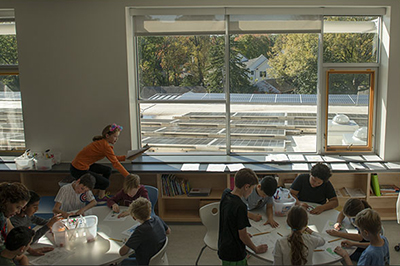Lighting and Student Performance
Lighting and Student Performance
Student Performance, Well-being, and Behavior (SPWB)
From the supporting literature (linked above), there is a benefit of providing daylight on student performance, well-being and behavior. There is a consistency that natural and adequate lighting improves students health, behavior, achievements, safety, and reduces their stress level. For improved students well-being, classrooms should not be with inefficient lighting.
Recommendations
1. Consider the orientation of windows in the design of classrooms.
1. Maximize naturalness and individual space use in the design of classrooms and school buildings.
3. Avoid designing classrooms without windows.
4. When designing classrooms and school buildings, emphasis should be on lighting, physical design, and facilities, learning spaces, indoor and outdoor air quality.
5. Consider students behavior and outcomes as it relates to lighting, in the design of classrooms and school buildings.
6. Maximize the use of natural lighting in the design and selection of window system.
7. Research on lighting and its use should be based on suitability for task, building, neighborhood, energy efficiency, aesthetic and lighting system performance.
8. Promote the use and design of user-friendly lighting control systems.
9. Promote the use of automated lighting control to reduce energy use.
10. Encourage the adoption of an integrated design approach.
11. Create a system that encourages feedback from the occupants and incorporate their feedback into the design.
12. Educate building occupants on the building design, control, and indoor environment.
References
1. Ariani, M. G., & Mirdad, F. (2015). The Effect of School Design on Student Performance. International Education Studies, 9(1), 175.
2. Barrett, Peter; Fay Davies; Yufan Zhang; Lucinda Barrett (2015). “The Impact of Classroom Design on Pupils’ Learning: Final Results of a Holistic, Multi-level Analysis”. Building and Environment, 89, 118-133.
3. Brown, Z.B (2009). “Occupant Comfort and Engagement in Green Buildings: Examining the Effects of Knowledge, Feedback and Workplace Culture”. The University of British Columbia, Vancouver, BC.
4. Blackmore, J., Bateman, D., Loughlin, J., O’Mara, J., & Aranda, G. (2011). Research into the connection between built learning spaces and student outcomes.
5. Bourgeois, D; Reinhart, C; Macdonald, I (2006). “Adding advanced behavioral models in whole building energy simulation: A study on the total energy impact of manual and automated lighting control”. ELSEVIER, 38(7), 814-823.
6. Grangaard E. M. (1995) Color and Light Effects on Learning. Paper presented at the Association for Childhood Education International Study Conference and Exhibition (Washington, DC, April 12-15, 1995)
7. Fisher, Kenn (2001) “Building Better Outcomes: The Impact of School Infrastructure on Student Outcomes and Behaviour. Schooling Issues Digest”. Department of Education, Training and Youth Affairs, Australia.
8. Ford, A. (2007). Designing the sustainable school, images publishing group Pty Ltd, Australia.
9. Hathaway, W., E. (1995). “Effects of School Lighting on Physical Development and School Performance.” The Journal of Educational Research, 88(4), 228-242., 228-242., 228-242.
10. Heschong L. (1999). “Daylighting in Schools: An Investigation into the Relationship Between Daylighting and Human Performance (HMG Project #9803)”. Heschong Mahone Group to Pacific Gas and Electric Company on behalf of the California Board for Energy Efficiency Third Party Program. <http://files.eric.ed.gov/fulltext/ED444337.pdf> (May 16, 2016).
11. Nicklas, M. H., and Bailey, G. B. (1996). “Student performance in daylit schools.” Innovative Design. Raleigh, North Carolina.
12. Plympton P., Conway S. Epstein K. (2000b). “Day lightening in schools: improving student performance and health at a price school can afford”, NREL/CP-550-28049, National Renewable Energy Laboratory, USA.
13. Takaoka, Motoko; Norbäck, Dan (2011). “The Influence of School Environment on the SBS Symptoms and the Development of Asthma and Allergy”. Sick Building Syndrome in Public Buildings and Workplaces, Springer-Verlag, Berlin Heidelberg.
14. Tanner, C. Kenneth (2009). “Effects of School Design on Student Outcomes”. Journal of Education Administration, 47(3), 381-399.
15. Veitch J.A; McColl S.L (2001). “A Critical examination of perceptual and cognitive effects attributed to full-spectrum fluorescent lighting”. Ergonomics, 44(3), 255-279.





